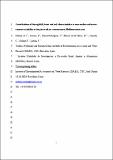Por favor, use este identificador para citar o enlazar a este item:
http://hdl.handle.net/10261/202368COMPARTIR / EXPORTAR:
 SHARE SHARE
 CORE
BASE CORE
BASE
|
|
| Visualizar otros formatos: MARC | Dublin Core | RDF | ORE | MODS | METS | DIDL | DATACITE | |

| Título: | Contributions of throughfall, forest and soil characteristics to near-surface soil water-content variability at the plot scale in a mountainous Mediterranean area |
Autor: | Molina, Antonio J.; Llorens, Pilar CSIC ORCID; Garcia-Estringana, P. CSIC ORCID CVN; Moreno de las Heras, M.; Cayuela, Carles CSIC ORCID; Gallart, Francesc; Latron, Jérôme CSIC ORCID | Palabras clave: | Soil moisture Forest hydrology Rainfall partitioning Soil water repellence |
Fecha de publicación: | 10-ene-2019 | Editor: | Elsevier | Citación: | Science of the Total Environment 647: 1421-1432 (2019) | Resumen: | Soil water-content (SWC) variability in forest ecosystems is affected by complex interactions between climate, topography, forest structure and soil factors. However, detailed studies taking into account the combined effects of these factors are scarce. This study's main aims were to examine the control that throughfall exerts on local spatial variation of near-surface soil water-content and to combine this information with forest structure and soil characteristics, in order to analyze all their effects together. Two stands located in the Vallcebre Research Catchments (NE Spain) were studied: one dominated by Quercus pubescens and the other by Pinus sylvestris. Throughfall and the related shallow SWC were monitored in each plot in 20 selected locations. The main characteristics of the nearest tree and soil parameters were also measured. The results indicated that mean SWC increment at the rainfall event scale showed a strong linear relationship with mean throughfall amount in both forest plots. The % of locations with SWC increments increased in a similar way to throughfall amount in both forest plots. The analyses considering all the effects together indicated again that throughfall had a significant positive effect in both forest plots, while soil litter depth showed a significant negative effect for the oak plot but lower statistical significance for the pine plot, showing a comparable –although more erratic– influence of the organic forest floor for this plot. These results, together with lower responses of SWC to throughfall than expected in rainfall events characterized by low preceding soil water-condition and high rainfall intensity, suggest that litter layer is playing an important role in controlling the soil water-content dynamics. The biometric characteristics of the nearest trees showed significant but very weak relationships with soil water-content increment, suggesting that stemflow and throughfall may act at lower distances from tree trunk than those presented in our study. © 2018 Elsevier B.V. | Versión del editor: | https://doi.org/10.1016/j.scitotenv.2018.08.020 | URI: | http://hdl.handle.net/10261/202368 | DOI: | 10.1016/j.scitotenv.2018.08.020 |
| Aparece en las colecciones: | (IDAEA) Artículos |
Ficheros en este ítem:
| Fichero | Descripción | Tamaño | Formato | |
|---|---|---|---|---|
| Contributions of throughfall, forest and soil characteristics to near-surface soil water-content variability at the plot scale in a mountainous Mediterranean area.pdf | Artículo principal | 6,17 MB | Adobe PDF |  Visualizar/Abrir |
CORE Recommender
SCOPUSTM
Citations
38
checked on 01-abr-2024
WEB OF SCIENCETM
Citations
37
checked on 29-feb-2024
Page view(s)
191
checked on 22-abr-2024
Download(s)
232
checked on 22-abr-2024
Google ScholarTM
Check
Altmetric
Altmetric
NOTA: Los ítems de Digital.CSIC están protegidos por copyright, con todos los derechos reservados, a menos que se indique lo contrario.
